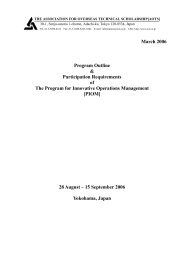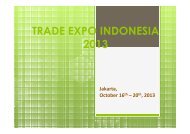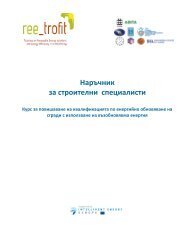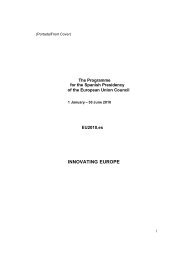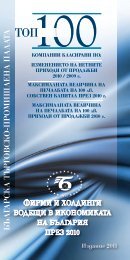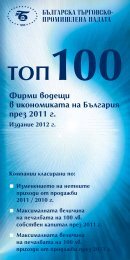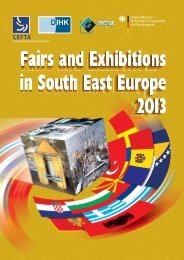Analysis of the Operation and Financial Condition of the Enterprise
Analysis of the Operation and Financial Condition of the Enterprise
Analysis of the Operation and Financial Condition of the Enterprise
You also want an ePaper? Increase the reach of your titles
YUMPU automatically turns print PDFs into web optimized ePapers that Google loves.
<strong>Analysis</strong> <strong>of</strong> <strong>the</strong> <strong>Operation</strong> <strong>and</strong> <strong>Financial</strong> <strong>Condition</strong> <strong>of</strong> <strong>the</strong> <strong>Enterprise</strong>income statement as by having a look at <strong>the</strong> net turnover <strong>of</strong> <strong>the</strong> enterprise in Table 4 (see<strong>the</strong> annex) ‘Income statement <strong>of</strong> <strong>the</strong> <strong>Enterprise</strong> N for <strong>the</strong> period from 31/12/2XX7 to31/12/2XX9’ <strong>the</strong> explanation for <strong>the</strong> trend <strong>of</strong> increase in <strong>the</strong> total assets can be found, as<strong>the</strong> increase in net turnover until <strong>the</strong> third quarter <strong>of</strong> 2XX8 is boosting; <strong>the</strong> decrease in <strong>the</strong>net turnover for <strong>the</strong> last quarter is due to <strong>the</strong> seasonal character <strong>of</strong> turnover in <strong>the</strong>construction business. The fact that starting with <strong>the</strong> end <strong>of</strong> March, 2XX9, <strong>the</strong> rates <strong>of</strong>increase in net turnover <strong>of</strong> <strong>the</strong> enterprise are rising is also explained by <strong>the</strong> seasonalchanges.In Table 5 (see <strong>the</strong> annex) it can be seen that in <strong>the</strong> second quarters <strong>of</strong> <strong>the</strong> year <strong>the</strong>net turnover <strong>of</strong> <strong>the</strong> enterprise is less than <strong>the</strong> cost <strong>of</strong> goods sold as during this period <strong>the</strong>enterprise is investing money in projects which it not necessarily gets back in <strong>the</strong> followingmonth, <strong>the</strong>refore, during <strong>the</strong>se periods <strong>the</strong> enterprise is working at a loss.Although <strong>the</strong> average quarterly net turnover is 282,7 thous<strong>and</strong> CU, it can be seenthat in <strong>the</strong> first quarter <strong>of</strong> 2XX9 <strong>the</strong> amount <strong>of</strong> net turnover is only slightly below <strong>the</strong>average, being higher during <strong>the</strong> rest <strong>of</strong> <strong>the</strong> year, but more importantly <strong>the</strong> turnover <strong>of</strong> <strong>the</strong>enterprise is more levelled than that in year 2XX8.5.2. Liquidity ratio analysis <strong>of</strong> <strong>Enterprise</strong> NOverall liquidityIn estimating this measure <strong>the</strong> overall liquidity calculation formula 4.1 must beapplied. In order to arrive at <strong>the</strong> overall liquidity value information about <strong>the</strong> total amount<strong>of</strong> <strong>the</strong> enterprise current assets <strong>and</strong> short-term assets should be available (see <strong>the</strong> data inTable 1 <strong>of</strong> <strong>the</strong> annex).Table 5.1Estimation <strong>of</strong> <strong>the</strong> <strong>Enterprise</strong> N overall liquidity for <strong>the</strong> period from 31/12/2XX7 to31/12/2XX9 (in CU)Dec.,2XX7March2XX8June,2XX8Sept.,2XX8Dec.,2XX8March2XX9June,2XX9Sept.,2XX9Dec.,2XX9Total currentassets 167 806 210 557 241 778 343 779 318 301 476 754 386 462 296 149 304 415Currentliabilities 192 442 217 224 315 697 296 244 327 454 470 252 545 623 477 655 418 595Overallliquidity 0,87 0,97 0,77 1,16 0,97 1,01 0,71 0,62 0,73It can be seen according to Table 5.1 that <strong>the</strong> overall liquidity in <strong>the</strong> period underreview is below st<strong>and</strong>ard as it is recommended that <strong>the</strong> overall liquidity ratio is within <strong>the</strong>limits from 1 to 2 (3 on some occasions). The value <strong>of</strong> liquidity has only been slightlyabove <strong>the</strong> critical limit <strong>of</strong> 1 at <strong>the</strong> end <strong>of</strong> September 2XX8 (1.16) <strong>and</strong> in March, 2XX9, -1.01.This means that <strong>the</strong> enterprise is having problems with paying its suppliers in duetime. By knowing that a major supplier has authorised a credit line to <strong>the</strong> enterprise with<strong>the</strong> limit <strong>of</strong> 40,000 CU available for one year with <strong>the</strong> option <strong>of</strong> extending it for one more93



